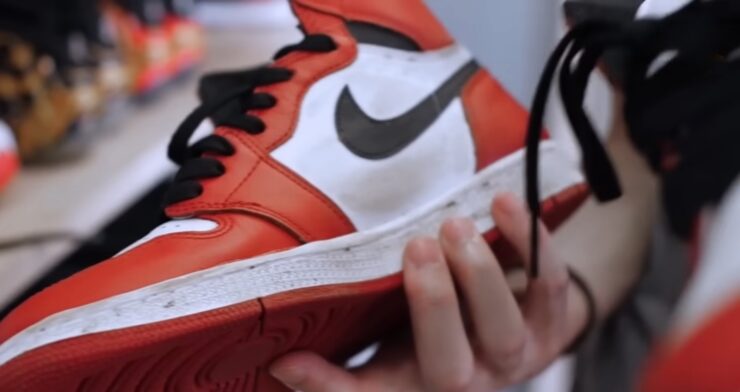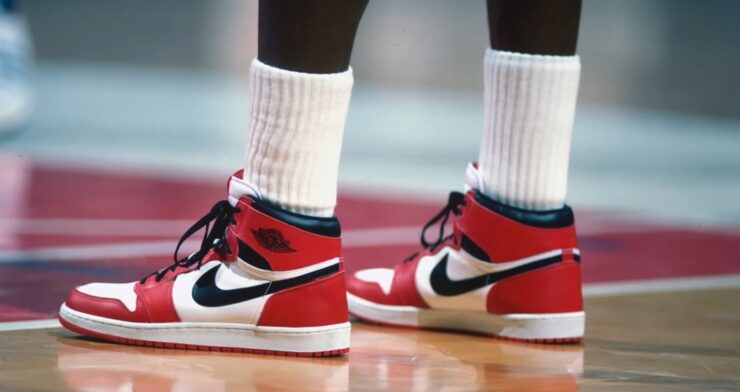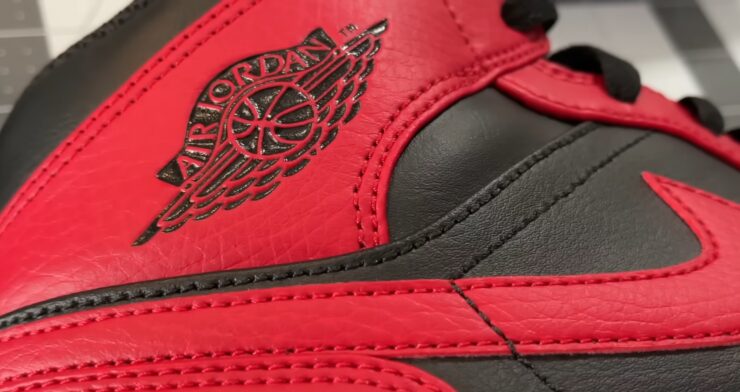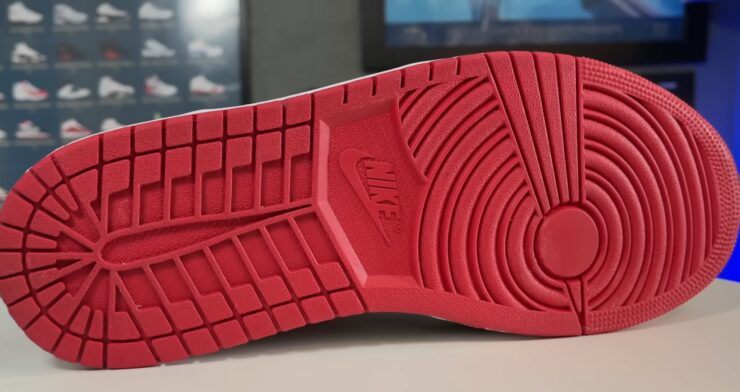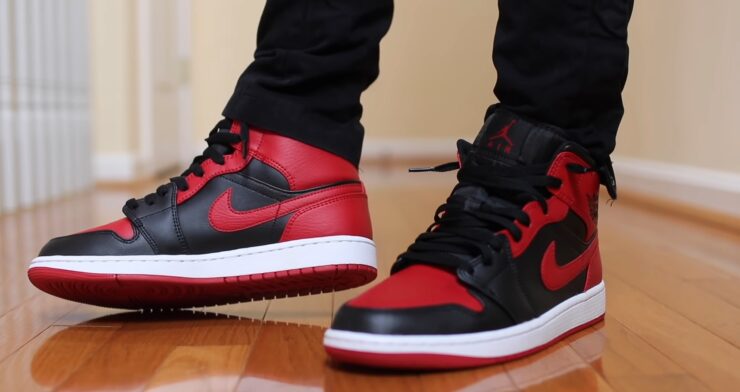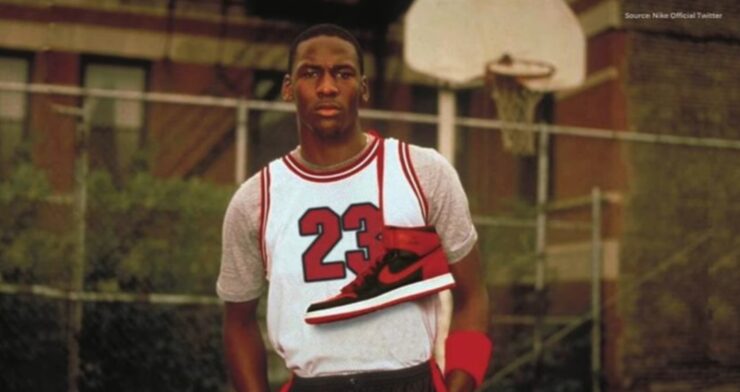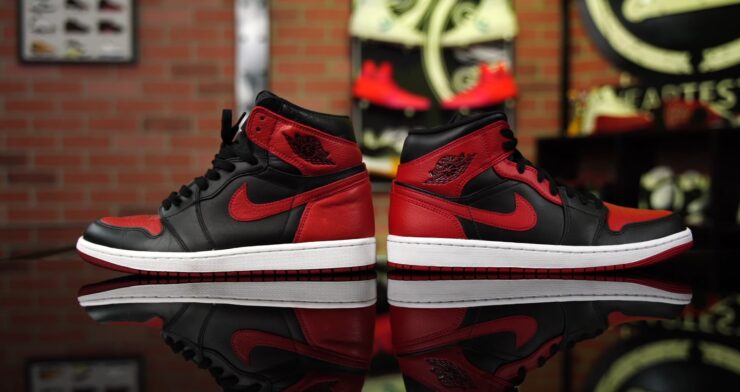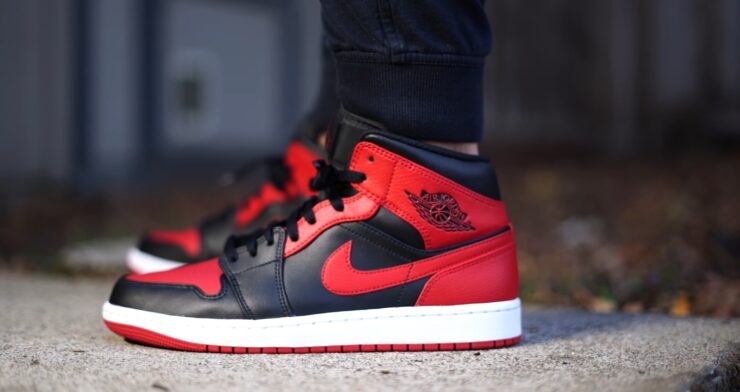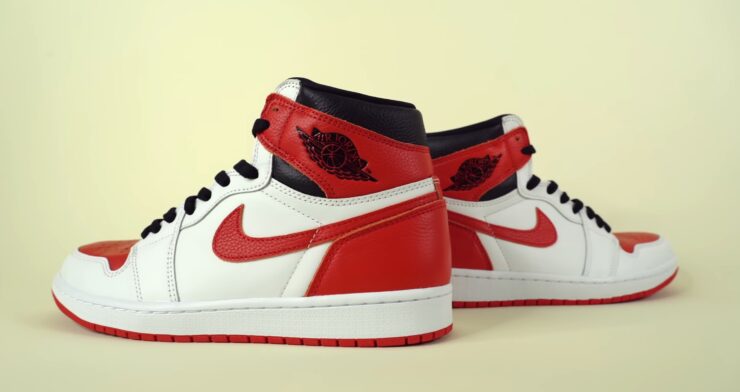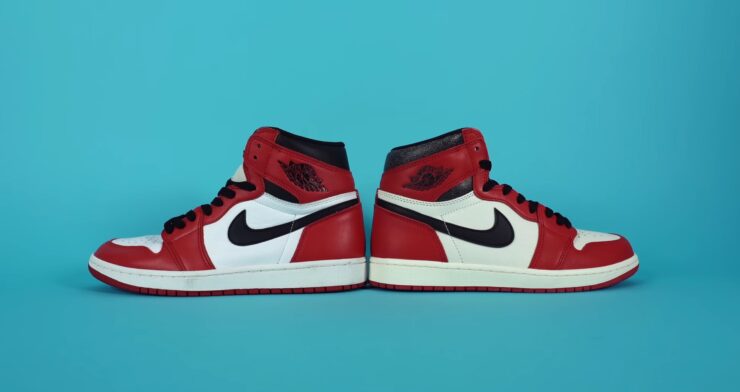The Air Jordan 1s are a legendary shoe in sneaker culture. It launched in 1985 and made headlines: David Stern banned it due to its non-regulation colors. The black and red design became a symbol of rebellion. Michael Jordan wore the shoes, incurring hefty fines for every game. This controversy only increased their demand, making them sought after by collectors and enthusiasts.
To understand why these Air Jordans matter, we must look to their history. In the ’80s, Nike took a risk by introducing vibrant colors to the basketball court. This daring move gained attention from fans and players. But David Stern felt it violated NBA rules.
Though initially rejected, Peter Moore’s design became a symbol of individuality. The sneaker market exploded with demand for Air Jordans 1s and Michael Jordan added to the fire by wearing these forbidden sneakers during games. He defied authority and pushed boundaries, creating an image of an extraordinary athlete and icon.
The shoe’s history
The shoes hold a significant place in sneaker history. This iconic shoe was initially prohibited by the NBA due to its controversial color scheme. Despite the ban, Michael Jordan continued to wear them, resulting in fines for each game. This incident propelled the Air Jordan 1s into popularity, making it one of the most coveted and collectible sneakers today.
They showcase a fascinating intersection of sports, fashion, and cultural influence. Its forbidden status not only added to its desirability but also set the stage for a new era in sneaker culture. The moment when Michael Jordan defiantly wore these shoes on the court marked a turning point in the relationship between athletes, brands, and sports governing bodies.
In addition to its historical significance, the Air Jordan 1s also stand out for their design and craftsmanship. The bold red and black colorway, inspired by the Chicago Bulls‘ team colors, became a defining feature of the Air Jordan line. The use of premium leather and the iconic Wings logo further elevated its appeal.
To truly appreciate the Air Jordans, it is essential to understand the deep-rooted passion and enthusiasm of sneaker enthusiasts. The shoe’s limited availability, unique history, and timeless design have contributed to its high demand and resale value. For collectors and fans alike, owning a pair symbolizes a connection to basketball history while also showcasing a sense of personal style and individuality.
The NBA’s ban
The Air Jordan 1s made their entrance in the basketball world during the early 1980s. But the NBA banned it for not meeting their strict uniform policy. This restriction only added more fire and made the Air Jordan line even more iconic.
The ban didn’t put a stop to its fame. Instead, it increased it. Basketball fans found the design of the sneakers bold and rebellious. Michael Jordan himself wore them, despite the ban, and this led to more support from his fans. It also gave a massive boost to both MJ’s career and Nike’s sales, transforming basketball fashion forever.
What makes this story unique is that, even though the NBA tried to suppress the shoes, they ended up making people want them more. Sneakerheads rushed to get their hands on a pair of Jordans, increasing demand and making them collector’s items.
The controversy surrounding the banned sneakers
These sneakers have a long and intriguing history. Let’s explore the controversy behind this iconic sneaker!
Firstly, the NBA commissioner, David Stern, banned these sneakers due to its bold black and red colorway, which violated league regulations. This ban caused a massive demand for the sneaker, making them even more desirable among fans and collectors.
It is believed that every time Michael Jordan wore these banned sneakers during games, he got fined $5,000! This only added to their allure and rebellious appeal. The banning highlighted a clash between artistic expression and traditional sports regulations. It became a symbol of individuality and defiance.
The ban also inadvertently caused the Air Jordan brand to go into pop culture, making it a cultural icon. In addition, the ban’s backlash brought attention to sneaker design, marketing strategies, and endorsement deals. Moreover, Nike capitalized on the ban by creating an ad campaign portraying Michael Jordan as a renegade athlete. This genius move increased sales and boosted Michael Jordan’s image.
The controversy surrounding these kicks still impacts sneaker culture. It has become a symbol of rebellion, creativity, and unparalleled style. Michael Jordan’s reaction to the ban? He reintroduced his passion for basketball to the world, along with some seriously stylish footwear.
Michael Jordan’s reaction to the ban
NBA Commissioner David Stern’s ban of the Air Jordan 1s in 1984 sent shockwaves through the basketball world. Michael Jordan, the shoe’s iconic face, was disappointed. But, he quickly turned this setback into an opportunity to make a statement. He wore the banned sneakers on court, receiving fines as a result. This rebellious act created a rebellious image for Jordan and the shoe.
Jordan first reacted with disappointment. He didn’t understand why such an innovative and stylish shoe had been restricted. To him, these shoes meant more than just a shoe—it symbolized his individuality and his desire to push boundaries.
But, instead of shying away from the ban, Jordan embraced it. He decided to wear the Air Jordans during games. His defiance showcased his rebellious nature and solidified his place in both basketball and popular culture.
The ban became a marketing goldmine for Nike. It also cemented their partnership with Jordan—one that defied conventions. Sneaker enthusiasts were drawn to the sneaker’s forbidden allure. The demand skyrocketed, propelling Jordan and the Air Jordan 1 into legendary status.
Design and features
Air Jordans are notable sneakers that showcase unique designs and features. Its distinct color scheme, comprising of black and red, sets it apart from other models. The shoe incorporates premium materials, such as leather, which adds to its quality and durability. Additionally, the Air Jordan 1s boast the iconic Nike swoosh logo on both sides, as well as the wing logo on the ankle collar. Its high-top silhouette provides ankle support, making it suitable for athletic performance and casual wear. Overall, these sneakers stand as a timeless and iconic shoe in the history of footwear.
In terms of design and features, the Air Jordan 1s can be summarized as follows:
- Unique color scheme: The shoe features a striking combination of black and red, which adds a bold and visually appealing element.
- Premium materials: Crafted with high-quality leather, the sneaker ensures durability and long-lasting comfort.
- Iconic branding: The Nike swoosh logo is prominently displayed on both sides of the shoe, emphasizing its association with the renowned athletic brand. Additionally, the wing logo on the ankle collar showcases the shoe’s Jordan lineage.
- High-top silhouette: The Air Jordan 1s incorporate a high-top design, providing support and stability for the wearer.
- Versatile style: While originally intended for basketball, the sneakers have become a fashion statement, suitable for both sports and everyday wear.
In addition to the aforementioned details, it is worth noting that these shoes have gained significant attention due to their association with a true story. Back in 1985, when NBA players were prohibited from wearing sneakers with “non-regulation” colors, Michael Jordan defied the rules and wore the Air Jordan 1s. This act of rebellion not only generated controversy but also solidified the shoe’s iconic status. These sneakers remain as a symbol of individuality and creativity, making it a coveted piece for sneaker enthusiasts worldwide.
The Air Jordan 1s were made with more than just legendary sneaker design, it was made with the tears of sneakerhead parents trying to keep their kids out of debt.
Colorway and materials used
The Air Jordan 1: where Nike Air branding and the iconic wings logo unite! It offers a bold statement with its black and red colorway. Crafted with meticulous detail, this sneaker showcases materials that guarantee longevity and luxury.
The Genuine leather upper provides a luxurious feel and the nylon tongue enhances breathability. The durable rubber outsole offers optimal traction while the Nike swoosh branding adds an unmistakable visual appeal.
In 1985, Michael Jordan famously wore these banned shoes, despite being fined by the NBA. Nike capitalized on this with a marketing campaign which propelled the popularity of Michael Jordan and the Air Jordan brand.
Nike Air branding and iconic wings logo
The Nike Air branding and the iconic wings logo are two distinct features of the Air Jordan 1 sneakers. The Nike Air branding signifies the relationship between Nike and Michael Jordan, while the wings logo symbolizes his capability to soar.
The Nike Air branding is on the tongue of the shoe, with the Nike logo and the word “Air” written beneath it. This logo represents Nike’s innovation and performance, as well as Jordan’s basketball legacy.
The wings logo is also eye-catching and meaningful. It is on the side of the shoes, close to the ankle. The logo consists of two wings, symbolizing Jordan’s strength and ambition.
Both the Nike Air branding and wings logo are useful. The Nike Air technology provides cushioning and support, while the wings logo supports ankles and prevents injuries.
High-top versus low-top versions
The shoes come in both high-top and low-top styles. The high-top offers enhanced ankle support, while the low-top provides a more relaxed fit. Let’s look at the differences between these two versions.
The high-top and low-top Air Jordan 1s have different key features. Here’s a breakdown:
| High-Top Version | Low-Top Version | |
|---|---|---|
| Ankle Support | Excellent | Limited |
| Comfort | Optimal | Relaxed |
| Style | Sleek and Classic | Modern and Versatile |
| Durability | Exceptional | Reliable |
| Performance | Ideal for Basketball | Suitable for Everyday |
The colorway is shared but each version has its own unique characteristics. The high-top is designed for basketball performance – optimal ankle support and comfort. The low-top offers a relaxed fit suited for everyday wear.
Michael Jordan played a huge role in popularizing both high-top and low-top sneakers. He wore high-tops in his early NBA years, then switched to low-tops in 1995. This sparked conversation and interest among fans.
Whether you go for the security of a high-top or the freedom of a low-top, these sneakers have got you covered. Its timeless design and history make it a must-have in the world of footwear. The Air Jordan 1s are back – a reminder that some shoes are too rebellious to ignore!
Retro releases
These shoes have seen several retro releases over the years, captivating sneaker enthusiasts and Jordan fans alike. Here are 5 key points regarding their return:
- The first retro release of the Air Jordan 1s took place in 1994, just nine years after the original launch.
- In 2011, Jordan Brand celebrated the 25th anniversary of the Air Jordan line by releasing a special edition of the colorway, labeled as the “Banned 1.5”.
- One of the most highly coveted retro releases occurred in 2016 when they returned as part of the iconic Banned/Shattered Backboard pack.
- The 2016 retro release stayed true to its original design with the notable ‘X’ symbol on the heel, representing the NBA’s ban.
- Continuing its popularity, they received another retro release in 2019 as part of the Jordan Brand’s “Fearless” collection, celebrating Michael Jordan’s legacy.
In addition to these notable releases, it is worth mentioning that these sneakers become one of the most sought-after sneakers in the Jordan Brand lineup. Sneakerheads and collectors eagerly anticipate any new potential retro iterations of this iconic shoe.
Initial retro release in 1994
These sneakers made their first retro launch in 1994. It caught the eye of sneaker aficionados with its classic style and great historical significance. This iconic shoe, which was released in 1985, was prohibited by the NBA due to violating uniform regulations. Its retro release in 1994 let fans relive the nostalgia of this groundbreaking sneaker.
This retro launch was a key moment in sneaker culture. Many fans eagerly waited for the chance to possess a piece of history and experience the rebellious allure of the shoe. With its striking black and red color scheme and iconic Nike branding, the Air Jordan 1s became an instant classic.
Despite being labeled as a retro launch, this iteration still retained the integrity of the original design. The high-top silhouette, premium leather construction, and signature wings logo on the ankle all stayed true to its heritage. Michael Jordan’s Nike Air cushioning provided excellent comfort and support on and off the court.
One remarkable story related to this retro launch includes a famous collector who journeyed from across the globe to get a pair. He faced various obstacles including flight delays and long lines, but his dedication never wavered. Eventually, he proudly showcased his kicks alongside his impressive collection, showcasing his love for sneakers.
The initial retro launch of the Air Jordan 1s united fashion fans and basketball fanatics. It was a reminder of Michael Jordan’s enduring influence on both sports and fashion. With each following retro release, this iconic sneaker has kept captivating hearts and inspiring new generations who recognize its timeless design and rich history.
Significant retro releases in recent years
The Air Jordan 1s have stirred up plenty of buzz amongst sneakerheads in recent years. Let’s take a closer look at some of the notable events:
- The 2016 Retro Release: This brought back the classic black and red upper, with the original design intact. People eagerly waited in line to get their hands on this iconic silhouette.
- Collaborations: This sneaker has also been part of collaborations with renowned artists and designers, resulting in creative interpretations that wowed fans.
- Limited Edition Drops: Limited edition releases have been introduced, creating a sense of scarcity and frenzy for those who seek these shoes.
This sneaker has transcended sporting boundaries, becoming a cultural icon. Michael Jordan was fined $5,000 for wearing them in 1985, due to NBA regulations.
To sum it up, these sneakers have seen numerous retro releases, collaborations, and limited edition drops. It’s gone from being banned by the NBA to being a cultural phenomenon – a true testament to its iconic status!
Impact and legacy
The Air Jordan 1s made a significant impact and left a lasting legacy in the sneaker industry. Its release in 1985 challenged the NBA’s rules about uniformity, leading to fines for Michael Jordan and creating a buzz that catapulted the brand’s popularity. The shoe’s rebellious nature and unique design paved the way for the sneaker culture we see today. Its influence is evident in subsequent Air Jordan models, collaborations, and the reselling market. This shoe’s impact on popular culture and its ability to transcend the world of sports is unparalleled.
Furthermore, these kicks revolutionized the athletic footwear industry and established a new standard for style and innovation. Its bold color scheme and striking design captivated sneaker enthusiasts and set a trend for combining athletic performance with fashion-forward aesthetics. As a result, these shoes became a cultural icon, with its popularity transcending the boundaries of sports and reaching a wider audience.
One unique detail worth mentioning is the re-release of the Air Jordan 1s in 2016, commemorating the shoe’s 31st anniversary. This event created a resurgence of interest in the model, both among long-time enthusiasts and a new generation of sneakerheads. The re-release further solidified the shoe’s status as a legendary and sought-after silhouette.
Influence on sneaker culture
The Air Jordan 1s have had a radical effect on sneaker culture. It brought celebrity endorsements to sneakers, teaming up athletes with brands. Its notoriety was fueled by the black and red colorway, which broke NBA rules. It also set a high-top design standard with Nike Air cushioning. The Air Jordan 1s became fashionable, with limited availability and exclusive releases. It stands for defying conventions and self-expression. Surprisingly, the ban of the shoe from NBA games actually worked in Nike’s favor. It got media attention, sparking curiosity among consumers and solidifying its legendary status in sports and fashion. And if you want to resell it, your wallet will say goodbye!
Collectability and resale value
The rarity of the Air Jordan 1s makes it a highly sought-after shoe. It’s a limited edition release, so it’s increasingly hard to find a pair in pristine condition.
Its historical significance – a shoe that defied NBA rules – adds another layer of desirability. Demand for this model remains strong among sneaker fans. It’s become an iconic symbol in popular culture, attracting fans from sports, fashion, and streetwear.
In terms of resale value, the condition of the sneakers matters. The better preserved and unworn they are, the higher their value will be. Collectors strive to acquire sneakers in excellent condition.
In 2018, a pair of game-worn sneakers sold at auction for $560,000. This makes it one of the most expensive basketball shoes ever sold. Even after 35 years, the Air Jordan 1s are still soaring in popularity.
FAQs
What impact did the NBA ban have on the Air Jordan 1s?
The NBA ban on the Air Jordan 1s increased their desirability and popularity. It turned the sneakers into a symbol of rebellion and defiance, making them even more coveted by fans and collectors.
What kind of legacy did the Air Jordan 1s leave behind?
The Air Jordan 1s have left a lasting legacy in the sneaker industry. Their impact on sneaker culture, fashion, and popular culture is unparalleled. The rebellious nature, unique design, and cultural significance of the Air Jordan 1s have influenced subsequent Air Jordan models, collaborations, and the reselling market.
Why are the Air Jordan 1s considered a cultural icon?
The Air Jordan 1s are considered a cultural icon because they transcended the boundaries of sports and became a symbol of style, individuality, and creativity. Their popularity and influence extend far beyond the basketball court, making them a coveted piece of footwear in the world of fashion and sneaker culture.


